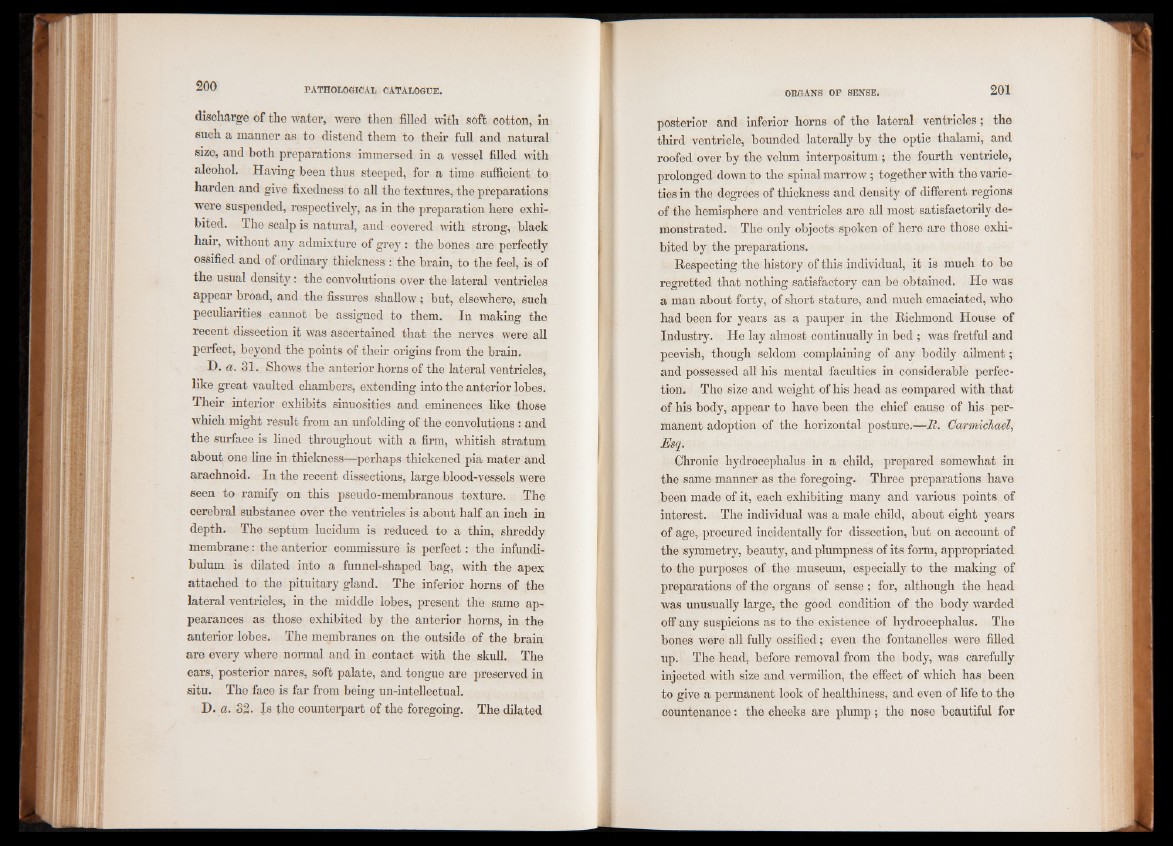
discharge of the water, were then filled with soft cotton, in
such a manner as to distend them to their full and natural
size, and both preparations immersed in a vessel filled with
alcohol. Having been thus steeped, for a time sufficient to
harden and give fixedness to all the textures, the preparations
were suspended, respectively, as in the preparation here exhibited.
The scalp is natural, and covered with strong, black
hair, without any admixture of grey: the bones are perfectly
ossified and of ordinary thickness : the brain, to the feel, is of
the usual density: the convolutions over the lateral ventricles
appear broad, and the fissures shallow; but, elsewhere, such
peculiarities cannot be assigned to them. In making the
recent dissection it was ascertained that the nerves were all
perfect, beyond the points of their origins from the brain.
D. a. 31. Shows the anterior horns of the lateral ventricles,
like great vaulted chambers, extending into the anterior lobes.
Their interior exhibits sinuosities and eminences like those
which might result from an unfolding of the convolutions : and
the surface is lined throughout with a firm, whitish stratum
about one line in thickness—perhaps thickened pia mater and
arachnoid. In the recent dissections, large blood-vessels were
seen to ramify on this pseudo-membranous texture. The
cerebral substance over the ventricles is about half an inch in
depth. The septum lucidum is reduced to a thin, shreddy
membrane: the anterior commissure is perfect: the infundibulum
is dilated into a funnel-shaped bag, with the apex
attached to the pituitary gland. The inferior horns of the
lateral ventricles, in the middle lobes, present the same appearances
as those exhibited by the anterior horns, in the
anterior lobes. The membranes on the outside of the brain
are every where normal and in contact with the skull. The
ears, posterior nares, soft palate, and tongue are preserved in
situ. The face is far from being un-intellectual.
D. a. 32. Is the counterpart of the foregoing. The dilated
posterior and inferior horns of the lateral ventricles; the
third ventricle, bounded laterally by the optic thalami, and
roofed over by the velum interpositum ; the fourth ventricle,
prolonged down to the spinal marrow; together with the varieties
in the degrees of thickness and density of different regions
of the hemisphere and ventricles are all most satisfactorily demonstrated.
The only objects spoken of here are those exhibited
by the preparations.
Respecting the history of this individual, it is much to be
regretted that nothing satisfactory can be obtained. He was
a man about forty, of short stature, and much emaciated, who
had been for years as a pauper in the Richmond House of
Industry. He lay almost continually in bed ; was fretful and
peevish, though seldom complaining of any bodily ailment;
and possessed all his mental faculties in considerable perfection.
The size and weight of his head as compared with that
of his body, appear to have been the chief cause of his permanent
adoption of the horizontal posture.—B. Carmichael,
Esq.
Chronic hydrocephalus in a child, prepared somewhat in
the same manner as the foregoing. Three preparations have
been made of it, each exhibiting many and various points of
interest. The individual was a male child, about eight years
of age, procured incidentally for dissection, but on account of
the symmetry, beauty, and plumpness of its form, appropriated
to the purposes of the museum, especially to the making of
preparations of the organs of sense; for, although the head
was unusually large, the good condition of the body warded
off any suspicions as to the existence of hydrocephalus. The
bones were all fully ossified; even the fontanelles were filled
up. The head, before removal from the body, was carefully
injected with size and vermilion, the effect of which has been
to give a permanent look of healthiness, and even of life to the
countenance: the cheeks are plump; the nose beautiful for